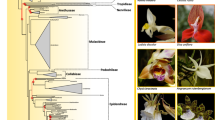The modern maidenhair tree has barely changed since the days of the dinosaurs.
Abstract
The maidenhair tree, or Ginkgo, is a gymnosperm that has been described as a 'living fossil' because it is known to have existed early in the Jurassic period 170 million years (Myr) ago, but a full understanding of its evolution has been impeded by a gap in the fossil record of more than 100 Myr — a crucial period during which the modern ovulate organs evolved from the Jurassic type1. Here we describe a new Ginkgo fossil that was collected from the Lower Cretaceous fossil Lagerstätte (the Yixian Formation2, which is over 121 Myr old3) in China and which fills this gap. This missing link reveals that Ginkgo's reproductive structures at that time were more like those of the present-day Ginkgo biloba than those of the primitive Jurassic type, indicating that their morphology has changed little for over 100 Myr.
This is a preview of subscription content, access via your institution
Access options
Subscribe to this journal
Receive 51 print issues and online access
$199.00 per year
only $3.90 per issue
Buy this article
- Purchase on Springer Link
- Instant access to full article PDF
Prices may be subject to local taxes which are calculated during checkout

Similar content being viewed by others
References
Zhou, Z.-Y & Zhang, B.-L Palaeontographica B 211, 113–133 (1989).
Chang, M.-M, Chen, P.-J, Wang, Y.-Q & Wang, Y. (eds) The Jehol Biota (Shanghai Science & Technology, Shanghai, 2001).
Swisher, C. C. III et al. Chinese Sci. Bull. 47, 135–138 (2002).
Rothwell, G. W. & Holt, B. in Ginkgo biloba — A Global Treasure from Biology to Medicine (eds Hori, T. et al.) 223–230 (Springer, Tokyo, 1997).
Crane, P. R., Manchester, S. R. & Dilcher, D. L. Fieldiana (Geol.) N. Ser. 20, 1–63 (1990).
Fuji, K. Bot. Mag. (Tokyo) 10, 104–110 (1896).
Zhou, Z.-Y. Acta Palaeontol. Sin. 33, 131–139 (1994).
Harris, T. M., Millington, W. & Miller, J. The Yorkshire Jurassic Flora IV: Ginkgoales and Czekanowskiales (Br. Mus. Nat. Hist., London, 1974).
Seward, A. C. Fossil Plants Vol. 4 (Cambridge Univ. Press, Cambridge, 1919).
Alberch, P., Gould, S. J., Oster, G. F. & Wade, D. B. Paleobiology 5, 296–317 (1979).
Author information
Authors and Affiliations
Corresponding author
Ethics declarations
Competing interests
The authors declare no competing financial interests.
Supplementary information
Rights and permissions
About this article
Cite this article
Zhou, Z., Zheng, S. The missing link in Ginkgo evolution. Nature 423, 821–822 (2003). https://doi.org/10.1038/423821a
Published:
Issue Date:
DOI: https://doi.org/10.1038/423821a
This article is cited by
-
Investigation of ginkgotoxin in different parts of Ginkgo seeds and its changes during low temperature storage and heating processing
Journal of Food Measurement and Characterization (2024)
-
A gene cluster in Ginkgo biloba encodes unique multifunctional cytochrome P450s that initiate ginkgolide biosynthesis
Nature Communications (2022)
-
Metabolomic and transcriptomic analyses of mutant yellow leaves provide insights into pigment synthesis and metabolism in Ginkgo biloba
BMC Genomics (2020)
-
Study on the Jehol Biota: Recent advances and future prospects
Science China Earth Sciences (2020)
-
Endophytes from Gingko biloba: the current status
Phytochemistry Reviews (2020)
Comments
By submitting a comment you agree to abide by our Terms and Community Guidelines. If you find something abusive or that does not comply with our terms or guidelines please flag it as inappropriate.



